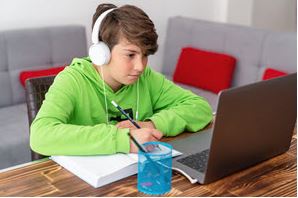5 Ways to Help Kids with Remote Learning
Posted
on Monday, October 19, 2020
in
Recent News

School is back in session. But as parents around the country know all too well, the start of this school year may not be like others. Students may be learning remotely full-time at home or through some combination of remote and in-person schooling. And though remote learning can be a convenient and safe way for children to learn, it doesn't come without its challenges — for parents and children.
Whether you're a parent who works inside or outside the home or stays at home, there are five steps you can take to make remote learning a success.
1. Establish a dedicated learning space. For many families in our new COVID-19 world, home has become our workplace and learning space. To help establish boundaries, you need to ensure that every member of your family has their own dedicated workspace. Ideally, each workspace will be in a quiet place that's free from distraction, such as a spare bedroom or office. Try to avoid high traffic areas, such as kitchens or playrooms, which present distractions. You'll also want to have table space available in your home where students can spread out to do art or science projects.
2. Establish a schedule. Children (and adults) need routine. That's why it's critical to create a daily and weekly schedule for your kids that will help them stay focused on tasks and assignments. To create that schedule, you'll want to meet with your children and review their assignments at the start of each week. Make that schedule accessible to each child, so that they understand what to expect. At the end of each day, meet to review the schedule for the next day.
3. Monitor progress. If you're working and have your own responsibilities, it's easy to lose track of your child's assignments and learning progress. One way to help monitor their learning and to keep them on track is to schedule a regular check-in each day. You can gauge progress and determine if your children might need some extra help with assignments.
4. Get 'em up and out. Kids need physical activity in order to enhance learning and alleviate anxiety. Build in time on the schedule every day for physical activity. For example, schedule a walk or run or time to shoot hoops in the driveway each day.
5. Stay social. Just as it's important to get exercise, it's important for kids and parents to socialize with others. Think about arranging safe, socially distanced play dates after school or setting up virtual gatherings.
Having your children learn at home definitely has its challenges. But, with some planning and organization, you can use this remote learning opportunity as a way to become even more involved in your children's learning, while spending quality time together.